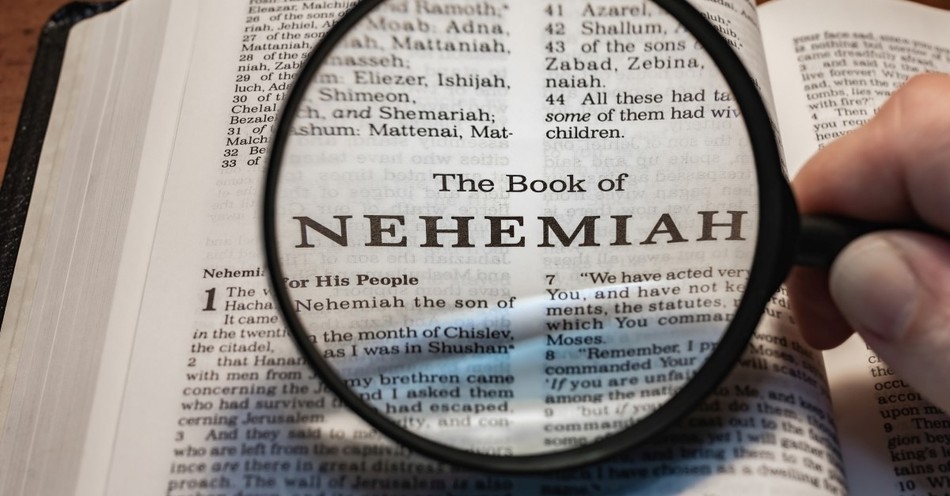We all cry for reconciliation. Divisions happen; relationships are broken. On a personal level, we long for healing with family or friends we love and miss. Our grief weighs upon us.
These individual situations mirror the separation between God and humanity. Through sin and pride, we experienced a rift between ourselves and the Creator, leading to our destruction and death. The separation becomes more painful since the Lord created us for intimacy and purpose, which can only be found in submission to him.
Thankfully, God’s love offers a way back. Even more, a way forward to an even greater reality and restoration, both individually and as a people, through the power of the Holy Spirit and the work of Christ.
The Jews cried out to God during their time in exile, first in Babylon and then in Persia. Due to their sin and idolatry, the Jews had lost the promised city of Jerusalem and their purpose as the chosen people of God. Yet the Lord promised reconciliation and restoration through the prophets. Nehemiah’s story reveals the struggle and victory of the process of restoration.
Who Was Nehemiah and His Story in the Bible?
Nehemiah was from the tribe of Judah, an exile during the time of Persia. The Bible doesn’t mention his direct ancestry but mentions his father as Hacaliah (Nehemiah 1:1), which might point to a more noble family, along with his position in the Persian court. Nehemiah lived during the fifth century BC, during the reign of King Artaxerxes I of Persia. While a Jew, Nehemiah grew up in the Persian Empire.
Despite being a Jew, Nehemiah acquired a position within the royal court, serving as the king’s cupbearer. In this trusted role, Nehemiah would taste the king’s drinks to test for poisoning. Likely, more Jews rose to certain positions as Daniel, Esther, and Mordecai found favor in Persia. Nehemiah’s role put him in a trusted and close relationship to the king and royal family.
Though he lived a comparatively luxurious and secure life within the king’s court, Nehemiah longed for the restoration of Jerusalem, which had been destroyed decades before by Babylon’s King Nebuchadnezzar. Nehemiah’s position and longing led to his purpose.
What is the Historical Context of the Book of Nehemiah?
The Persian Empire had been established by Cyrus the Great and then expanded by the following kings, Darius I and Xerxes I. After conquering Babylon, Persia grew to stretch from modern day India to Egypt and Greece. Nehemiah served as cupbearer under Artaxerxes I (465-424 BC). That king continued expanding, even though Persia failed to conquer Greece. Nehemiah lived in a time of stability and relative peace in the empire, although there were smaller rebellions in places like Egypt.
In earlier times, Cyrus had allowed exiled people like the Jews to return to their homelands and rebuild their cities and restore their local worship. Even though some Jews had returned to Jerusalem, the city remained in ruins, especially the city walls. Since the Persian law respected law and policy from previous kings, especially Cyrus, Nehemiah took advantage of this.
Nehemiah’s mission aligns with what history knows of Persian political practice. Persian kings appointed local leaders to govern their own people. Since the king allowed these roles, the local leaders owed the empire allegiance.
Neither Persian nor Greek records mention Nehemiah. However, his story makes sense within Persian culture and policy. The Elephantine papyri from an Egyptian Jewish community record other Jews in various Persian regions and even reference a governor of Judah, who might have been Nehemiah. Either way, these writings support the existence of a Jewish governor under Persia.
What Is Nehemiah’s Biblical Context?
God’s people failed their part of the covenant, and after many prophets warned them, God stayed true to his word and exiled them for their sin and idolatry. The Assyrians conquered the northern kingdom of Israel in 722 BC and dispersed them to other lands. Even with this example, the southern kingdom of Judah continued in their sin, and Babylon conquered them and took many captive, destroying the city and Solomon’s Temple in 586 BC. The exile lasted 70 years, fulfilling a prophecy by Jeremiah (Jeremiah 25:11), also affirmed by Daniel (Daniel 9:2).
After Babylon fell to the Medes and Persians in 539 BC, Cyrus allowed the Jews to return to their land (Ezra 1:1-4). The people of God first returned under Zerubbabel, and they focused on rebuilding the temple, first establishing right worship of the only God. Later, Ezra the priest/scribe came to Jerusalem to share God’s Law and call the people to repentance and faithfulness (Ezra 7). Nehemiah came in a later return, probably 445 BC, and he focused on rebuilding the walls, symbolic of defense and boundaries.
Nehemiah and Ezra worked together. Nehemiah organized and led the people politically to rebuild Jerusalem. Ezra led the spiritual life. Nehemiah 8 records Ezra reading the Mosaic Law to those Jews who had returned to Jerusalem, and a type of revival breaks out. As the Messiah was prophesied as both a king and priest, Nehemiah and Ezra together fulfilled these roles.
Two main prophets spoke and wrote during this time of rebuilding the temple, around 520 BC. The prophets Haggai and Zechariah encouraged the people to repent from breaking the covenant with God and rebuild the Temple. Haggai mainly called out how the people focused on their own lives instead of rebuilding the Temple. Zechariah gave powerful visions of hope, promising a future blessing over Jerusalem as a home for Jews and Gentiles, all nations to worship the God of all creation.
Ultimately, the Jews saw the rebuilding of the Temple and Jerusalem as central to the coming Messiah, since many Old Testament prophecies about Christ centered on those places. Nehemiah reveals through one man God’s ability to call and restore hope to a people.
What Was Nehemiah’s Purpose in Jerusalem?
Nehemiah heard a report from other Jews who had returned to Jerusalem. The walls of that holy city were still in ruins, the people there expressing grief. Nehemiah entered that sorrow, too. He fasted, wept, and prayed for days, confessing the sins of Judah and begging for God to act (Nehemiah 1).
As cupbearer with a relationship to the king, he appeared before Artaxerxes one day with a grieving expression. Culturally, this was a huge risk, since Persian officials were supposed to stay cheerful in the king’s presence. However, the king had mercy on Nehemiah and asked why he was so sad. Nehemiah prayed in his heart and boldly explained why—the condition of Jerusalem and his people. Nehemiah showed greater courage by asking permission to return and rebuild the city. Amazingly, Artaxerxes agreed and gave letters of protection and materials for the work (Nehemiah 2:1-8).
Nehemiah arrived in Jerusalem and inspected the walls at night. He rallied and organized the people to start the project, making every man responsible for their part. Under his leadership, they miraculously rebuilt the walls in 52 days (Nehemiah 6:15).
As governor, he also partnered with Ezra to restore right worship, stand against injustice, and reestablish the covenant with God. Nehemiah addressed corruption and oppression, from within and without. He led through prayer and conviction through major obstacles and resistance. Ezra focused on calling people back to a singular focus on God to renew their covenant, symbolized by rebuilding the temple. The walls symbolized the boundaries of Jerusalem, like the boundaries of heaven. Walls guide people to the correct gate, the right way in. This looks forward to how Jesus alone is the gate into heaven.
What Obstacles Did Nehemiah Face in Rebuilding?
Certain enemies resisted the rebuilding of the walls from the very beginning. These included Sanballat the Horonite, Tobiah the Ammonite, and Gershem the Arab. They argued that Jerusalem had a history of rebellion and fierce independence, especially as a monotheistic society, not allowing for any other gods. Rebuilding the walls would empower more rebellion, they thought. These enemies mocked the Jews and accused Nehemiah of fostering rebellion against Artaxerxes (Nehemiah 2:19), trying to discourage and intimidate the Jews into stopping the project.
Nehemiah and the Jews continued, however, and the opposition grew more intense. The enemies strategized a plan to attack Jerusalem and create chaos and confusion (Nehemiah 4:8). Nehemiah prayed and set guards with swords to protect the workers, dividing the people in half so one group built while the others remained ready for battle. He even had workers carry a sword while building. All the while, Nehemiah declared God’s protection over them. “Our God will fight for us.” (Nehemiah 4:20)
Unfortunately, Nehemiah encountered resistance among the Jews, as well. A few nobles wouldn’t help rebuild (Nehemiah 3:5), and a famine caused economic problems. As the famine hit, wealthy Jews charged interest and took property from the poorer Jews, all against the Mosaic Law (Exodus 22:25, 22:26-27). Nehemiah stood against this injustice, and the people praised God for the end of oppression (Nehemiah 5).
Later, enemies tried to get Nehemiah to leave the city, hoping to ambush him. When Nehemiah stayed, they falsely accused him of rebellion and even hired false “prophets” to intimidate him. Nehemiah prayed and wouldn’t stop or be silenced, saying, “Should a man like me flee?” (Nehemiah 6:11)
We should recognize the theme of prayer in Nehemiah’s life. From the beginning, he asked for God’s help and interceded for the project, especially when facing great resistance. With faith, prayer, and extreme courage, Nehemiah inspired the Jews, confronted injustice, and stayed on mission, rebuilding the walls of a city in 52 days.
How Does Nehemiah Offer a Future Hope?
As we can imagine, the Jews dealt with guilt and grief, experiencing the consequences of their sin as slaves or second-class citizens of pagan empires. The Lord sent hope, which came to fruition through Nehemiah. God offered restoration to the Jews and Jerusalem. Prophets like Jeremiah and Isaiah declared judgment for sin. Yet after, Yahweh would gather his people and restore them to the Promised Land (Jeremiah 29:10; Isaiah 44:28). Nehemiah’s leadership and purpose in rebuilding the city’s walls directly fulfilled these promises. God hadn’t abandoned his people, even after such traumatic failure and exile.
Restoring the Temple and Jerusalem with Ezra and Nehemiah went beyond their immediate context. These events also gave hope for God to send the Messiah. Without the return to the land, reestablishing right worship and the city, Messianic prophecies couldn’t be fulfilled. Yet because of the Jewish return, Jesus was born in Bethlehem, ministered in Galilee, and died in Jerusalem. Nehemiah’s obedience fulfilled a step toward a much grander and redemptive future.
For us today, Nehemiah reminds us to look forward to a greater, final hope: the return of the Lord Jesus Christ, the new heaven and earth, and the eternal New Jerusalem. Revelation 21 shows us a city where God dwells with his people, where every tear is wiped away, and death has been removed. Nehemiah’s Jerusalem was temporary, and we see ruins of the Second Temple and the city today. But the New Jerusalem of God’s people, built with eternal materials, will never fade or be destroyed, forever filled with God’s glory.
With this in mind, we seek first the Kingdom of God, here now and coming in fuller reality at Jesus’ return. Every Christian (like every Jew) participates in spreading the Kingdom Gospel of Jesus Christ. And like Nehemiah and the Jews of his day, we will experience obstacles and resistance, from within and without. Yet with prayer, faith, hope, and loving boldness, we will also overcome miraculously to see the New Jerusalem upon his return.
Peace.
Photo Credit: © Getty Images/Jon Frederick




.png)